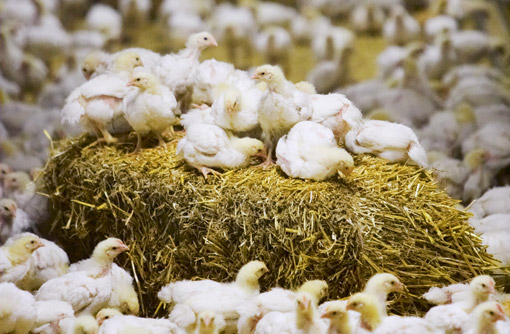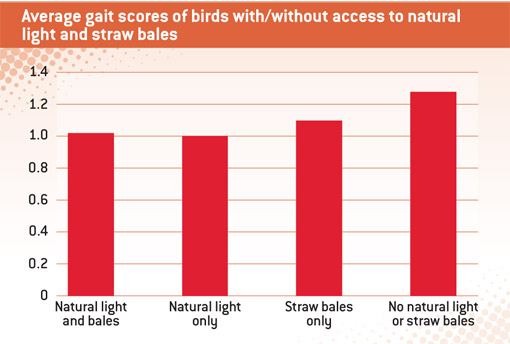Counting the benefits of broiler shed enrichments

There has been such an expansion in retailer and assurance scheme requirements for broilers to be produced in houses with windows that it is now almost the norm.
This can be costly in terms of retrofitting and increased heating bills, as most windows are much less well insulated than the house wall. Is this cost justified?
Certainly many producers have been quoted as enjoying the “cheerier and brighter” working environment. But it also seems that the birds benefit too.
Compared with conventional, artificially lit houses, with a typical light intensity of 11 lux, houses with windows are much brighter, displaying average light intensities of around 85 lux. This allows easier compliance with the new EU Broiler Directive (which requires a minimum light intensity of 20 lux at birds’ eye level), and may reduce the need to switch on lights during daylight hours, potentially saving producers money.
Studies by researchers at Queens University Belfast involving 16 paired broiler flocks show that birds in naturally lit sheds are significantly more active and have reduced gait scores, which indicate improved walking ability.
Another benefit of the increased activity and ground pecking/scratching is the significantly better litter quality found in houses fitted with windows.
But what about other enrichments such as straw bales, perches and pecking objects?
Research teams at the University of Bristol and Queen’s University have been studying these different elements, to assess the effect on bird welfare, as well as their physical performance.
Bales
Plastic-wrapped, treated, chopped straw bales were used as they were seen to be less of a biosecurity and health risk. The stockmen slit the plastic after three weeks enabling the birds to then forage and dust-bathe in the contents.
The Bristol study found birds at all ages huddled and slept next to the bales, but couldn’t easily access the top until they were over three weeks of age. They pecked at the plastic throughout.
In the Queen’s study, birds provided with straw bales remained standing for significantly longer when disturbed than those without access to bales, suggesting a positive effect on leg condition.
Perches
Large wooden A-frames designed for adult birds were employed in the Bristol study. Chicks could only access the lower rungs of these frames, and about half their attempts to perch failed. However, by five weeks of age, 90% of perch attempts were successful and birds accessed all levels, using the perches for resting, preening and observing activity below them. There were no downsides of breast meat quality associated with perch use.
Single-rung perches were provided in a Queen’s trial and, as in the Bristol trial, use of perches increased with bird age, peaking during week five of the rearing cycle. An average of 24 birds were seen perching on a single perch in a 25min observation period.
Pecking objects
String: Birds tended to peck at and “tease apart” strands of white nylon string provided in a Queen’s trial. Each length of string received an average of 19 bouts of pecking within a 25min observation period. Reduced gait scores were witnessed in birds provided with string compared with those without, suggesting positive effects of string on walking ability.
CDs: The Bristol study found birds did not become bored with CDs hanging from the feed line in different parts of the houses; on average each received 10 pecks/min throughout and even more when the birds were observed at three weeks of age.
Peckablocks: Unsurprisingly these blocks of compressed grains were highly attractive and needed replacing, which could be costly. Each block received up to 200 pecks during a five-minute observation period.
Flock performance
Overall, the studies showed that broilers reared in windowed houses with several enrichments spend significantly less time lying during the light period.
Importantly, none of the studies showed any downsides in terms of growth rate, feed conversion efficiency, culls or mortality. Most of the flocks provided with one or more of these enrichments had significantly greater levels of activity and improved walking ability.
While most flocks showed no significant differences in pododermatitis and hock burn, probably because the levels were low anyway, there was a consistent trend towards reduced skin lesions.

The behaviour of birds was more varied because they had the opportunity to interact with the various objects, and perform activities such as perching and extra dust-bathing. No extra aggressive pecking was witnessed in enriched birds, although younger birds engaged in higher levels of sparring (play-fighting) in the Bristol trials.
A possible negative consequence of providing enrichment may be the increased disturbance of resting birds (but not underneath the perches), in enriched houses. However, as all birds had a long period of darkness at night for resting, it may be that active birds “jostled” inactive birds, stimulating activity and reducing the length of lying bouts of those birds. This increase in activity could potentially improve the leg health of birds.
